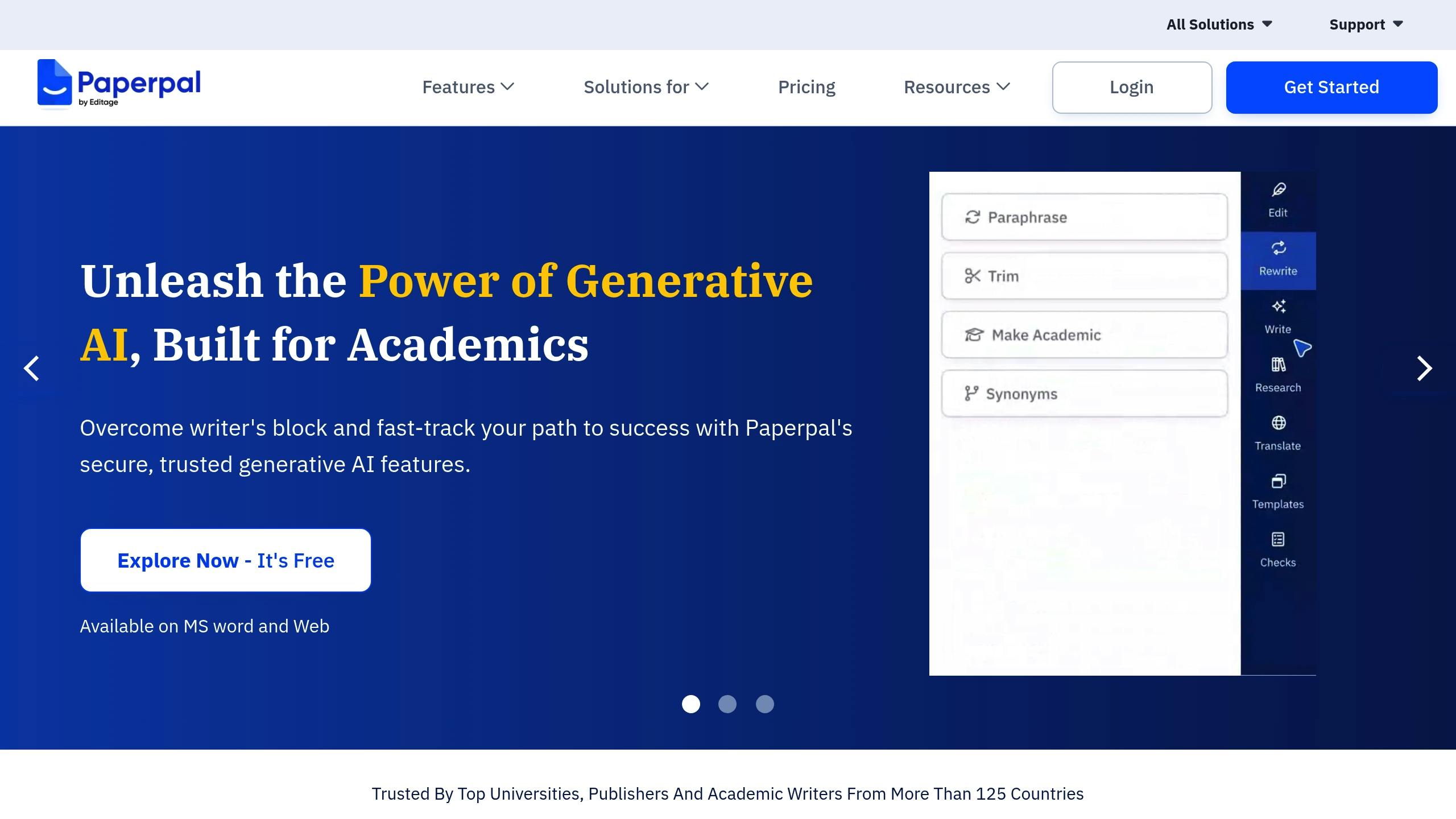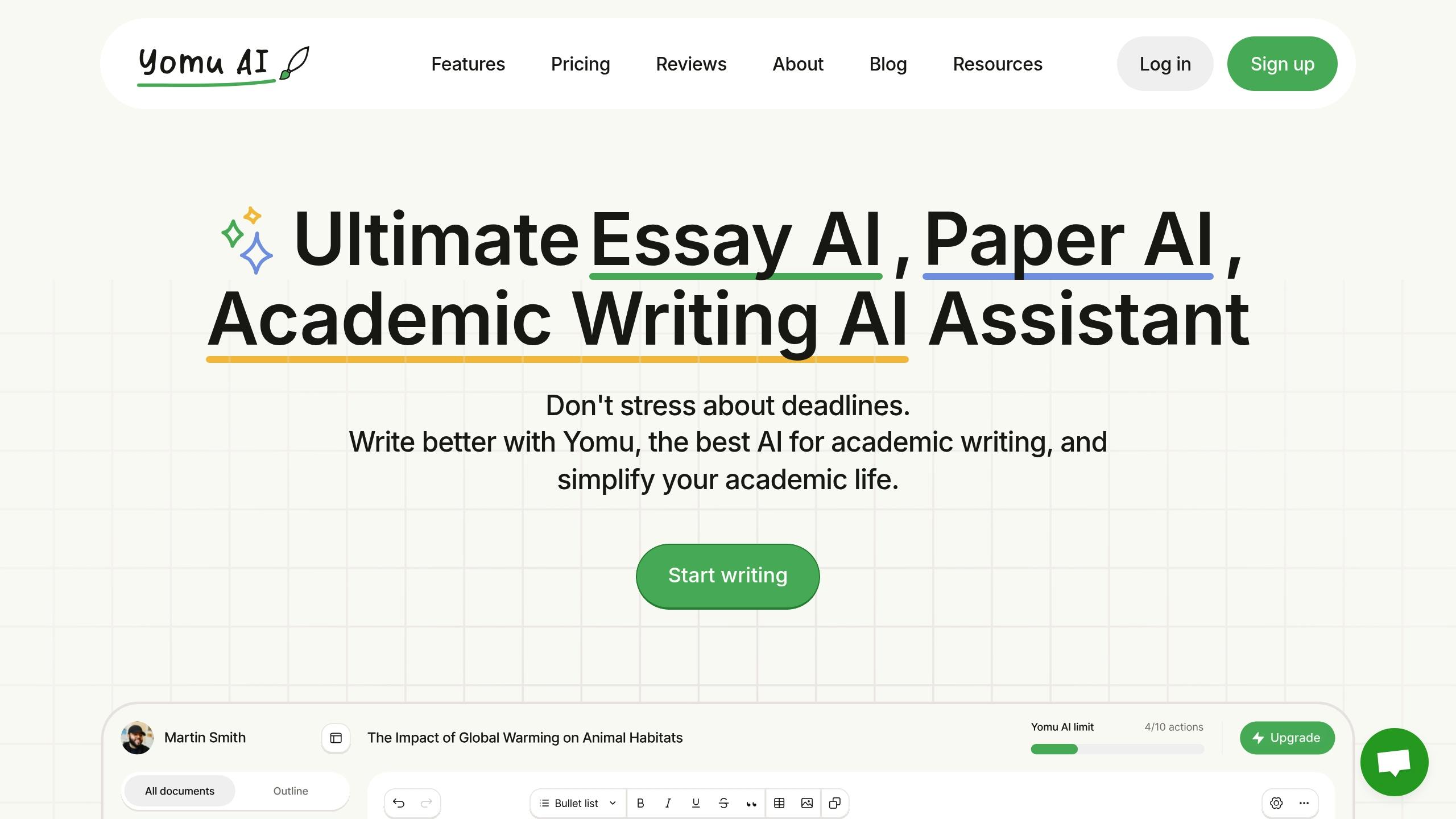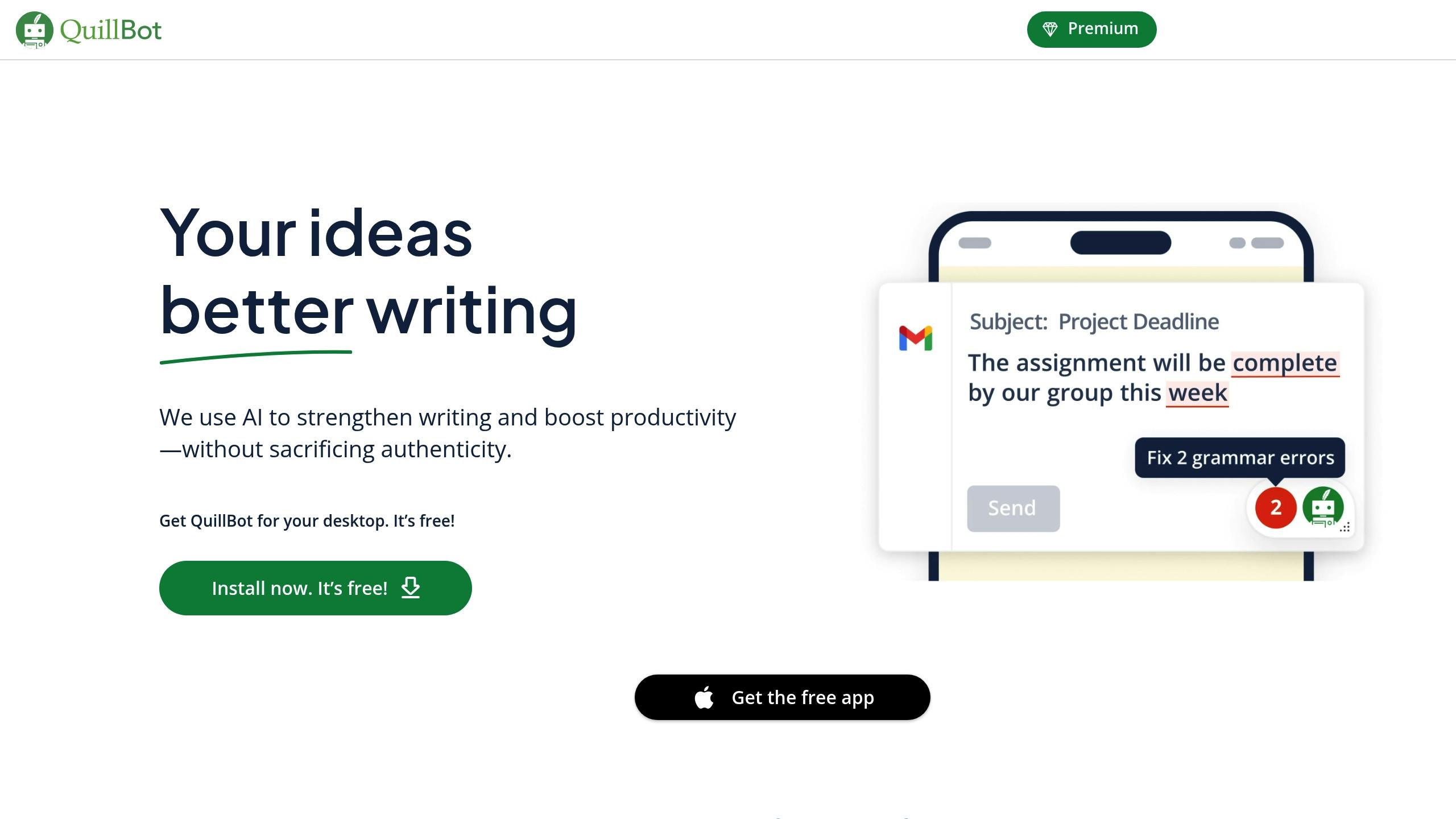
Scientific Writing AI
AI tools are transforming scientific writing, making it faster and more efficient for researchers. These tools tackle common challenges like tight deadlines, writer's block, and maintaining academic standards by automating repetitive tasks and improving text quality. Here's what they offer:
- Smart Text Completion: Tools like Paperpal and Yomu AI provide subject-specific suggestions and refine academic language.
- Text Refinement: Platforms like Trinka AI and QuillBot enhance clarity, flow, and tone while addressing complex grammar issues.
- Citation Management: Paperpal and ResearchRabbit simplify citation formatting and reference organization.
- Originality Checking: Tools like Copyleaks and PlagScan ensure plagiarism-free content.
Quick Comparison of AI Tools for Academic Writing:
| Tool | Features | Use Case |
|---|---|---|
| Paperpal | Text suggestions, citation checks, grammar | Manuscript preparation and editing |
| Trinka AI | Advanced grammar and style corrections | Polishing academic writing |
| Yomu AI | Paraphrasing, summarizing, plagiarism check | General academic writing assistance |
| SciSpace | Interactive research paper navigation | Literature reviews and research insights |
AI is not replacing researchers but supporting them to focus on their ideas while maintaining high academic standards.
Jenni AI vs PaperPal: Best AI Tools for Academic Writing

Main Features of Academic Writing AI
AI tools assist academic writers by simplifying tasks like text generation, editing, citation management, and originality checks.
Smart Text Completion
Platforms like Paperpal and Yomu AI provide context-aware, subject-specific suggestions that help writers overcome blocks and maintain consistent academic language. These tools analyze the surrounding text to offer relevant completions that align with academic standards. Once the text is completed, they also enhance clarity and refine style.
Text Refinement Tools
AI-powered tools are designed to help researchers polish their writing to meet academic expectations. For example, Trinka AI goes beyond basic grammar checks, addressing complex issues.
Meanwhile, QuillBot and SciSpace offer paraphrasing tools that assist researchers in:
- Improving clarity and readability
- Preserving an academic tone
- Using appropriate terminology
- Strengthening overall text flow
Citation Tools
Properly managing references and formatting citations is a critical part of academic writing. AI tools simplify this process significantly. Paperpal for Manuscript, for instance, offers instant checks for:
- Reference formatting
- Citation accuracy
- Table and figure citations
- Word count adherence
- Document structure
ResearchRabbit enhances this by helping researchers organize their reference libraries and apply correct citation styles across various academic formats.
Originality Checking
Upholding academic integrity is crucial. Plagiarism detection tools like Copyleaks and PlagScan use advanced algorithms to analyze text at a deeper level. These systems can identify potential plagiarism even when the wording has been altered, ensuring researchers maintain originality in their work.
Best AI Writing Tools for Research
Researchers today have access to AI tools that make academic writing more efficient while maintaining high scholarly standards. These tools are designed to tackle common writing challenges and provide practical solutions. Below are some standout platforms in this space.
Yomu AI

Yomu AI is tailored for academic writing, offering features like AI-driven sentence and paragraph completion. It also includes tools for paraphrasing, summarizing, and improving text. Its built-in citation and plagiarism checkers help ensure proper attribution, making it a reliable choice for researchers.
Paperpal, another major tool, brings a comprehensive set of features to academic writing.
Paperpal
Paperpal focuses on academic writing support with an AI engine trained on millions of editorial corrections across over 1,300 subjects. Trusted by 13 major publishers and integrated with 400+ academic journals, it offers:
| Feature | What It Does |
|---|---|
| Real-Time Language Suggestions | Provides subject-specific writing improvements |
| Reference Formatting | Automatically applies correct citation styles |
| Document Structure Analysis | Helps organize academic papers effectively |
| Editorial Quality Checks | Prepares manuscripts for professional submission |
While Paperpal fine-tunes your manuscript, SciSpace changes how researchers interact with academic literature.
SciSpace

SciSpace transforms static research papers into interactive documents using tools like ChatPDF. It helps researchers navigate dense scientific literature, create structured outlines, and extract critical information with ease.
Quillbot

Quillbot is a versatile tool that addresses over 3,000 grammatical issues, helping researchers write faster without compromising on quality. Its main features include:
| Feature | Purpose |
|---|---|
| Grammar Correction | Fixes complex language errors |
| Academic Tone Adjustment | Ensures a polished, scholarly style |
| Text Refinement | Improves clarity and flow |
| Summary Creation | Generates clear, concise research overviews |
These tools not only improve writing quality but also pave the way for deeper integration of AI in academic research workflows.
sbb-itb-1831901
Using AI in Academic Research
AI isn't just helping with writing anymore - it's transforming academic research and literature reviews. These tools address challenges like tight deadlines and writer's block, while also improving the quality of research and writing.
Research Review Methods
AI tools like SciSpace and Scholarcy make literature reviews faster and more organized by summarizing complex research.
| Task | AI Tool | Benefit |
|---|---|---|
| Analyzing Literature | Semantic Scholar | Highlights key papers and findings |
| Summarizing Content | Scholarcy | Provides concise overviews of research |
These tools simplify the review process, making it easier to develop well-researched manuscripts.
Writing Speed and Quality
AI tools like Paperpal help researchers write more efficiently, offering real-time feedback to improve grammar, clarity, and structure.
| Writing Feature | AI Tool's Role | Outcome |
|---|---|---|
| Grammar | Instant corrections | Simplifies editing |
| Style | Subject-specific suggestions | Keeps tone academic |
| Structure | Organizational feedback | Enhances readability |
These features save time while ensuring the writing meets academic standards.
Academic Standards
AI also helps maintain rigorous academic standards. Tools like Scite.ai ensure proper citation formatting, while PlagScan and Copyleaks check for originality. Taylor & Francis even provides AI-powered tools for format-free submissions, easing the process of meeting journal guidelines.
| Standard | AI Tool | Purpose |
|---|---|---|
| Citation Management | Nyckel | Formats citations automatically |
| Plagiarism Detection | Copyleaks | Ensures originality |
| Journal Requirements | Format-free submission tools | Simplifies compliance |
AI tools are here to assist researchers, not replace their expertise, ensuring academic work remains authentic and high-quality.
Key Takeaways
Main Points
AI tools are reshaping how scientific writing is done by automating repetitive tasks and making the process faster and more efficient. For instance, a 2024 case study by Paperpal revealed that researchers experienced a 50% reduction in manuscript preparation time and a 30% improvement in publication success rates. This allows researchers to focus more on their ideas rather than getting bogged down by routine editing.
These advancements hint at even more progress on the horizon.
Emerging Trends in AI Writing
AI-driven academic writing tools are becoming more advanced. Modern platforms now offer features like subject-specific recommendations, smarter writing assistance, and better tools for detecting plagiarism. For example, Yomu AI includes AI-powered sentence completion and smart document assistance tailored specifically for academic needs.
Looking ahead, deep learning and specialized models are expected to enhance text analysis and support highly technical writing. At the same time, there’s a growing emphasis on ethical AI usage to ensure transparency and proper attribution. These developments point to a future where AI tools continue to improve scientific writing while maintaining academic integrity.
FAQs
How to use AI responsibly in academic writing?
Using AI in academic writing involves blending technology with thoughtful human oversight. Here's a summary of key practices to ensure academic integrity while using AI tools:
| Aspect | Best Practice | Implementation |
|---|---|---|
| Fact Verification | Double-check AI-provided details | Cross-check facts, figures, and citations with multiple trusted sources. |
| Critical Analysis | Maintain independent thinking | Use AI to assist your analysis, not as a replacement for your original ideas. |
| Citation Management | Properly attribute sources | Clearly document AI tools used and format references accurately. |
| Content Review | Thoroughly review content | Check AI-generated material for logical consistency and overall correctness. |
It's also important to use plagiarism detection tools that analyze text at a deeper level, ensuring originality and adherence to academic standards.
